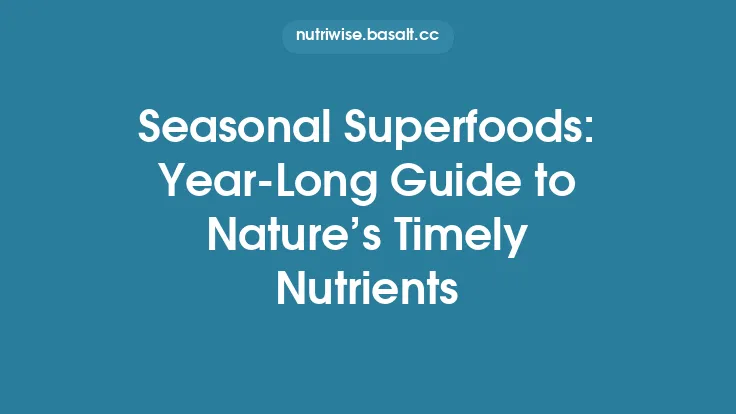Indigenous superfoods have been celebrated for generations within their communities for their vibrant flavors, resilience in harsh environments, and the subtle ways they enhance everyday meals. While many of these ingredients—such as wild rice, tepary beans, amaranth, and seaweed—originated in specific cultural contexts, they can be seamlessly woven into contemporary cooking without compromising their heritage. By understanding the unique characteristics of each superfood, sourcing responsibly, and applying thoughtful culinary techniques, home cooks can enrich their daily plates with nutrition, taste, and a touch of cultural reverence.
Understanding Indigenous Superfoods
Indigenous superfoods are more than just “healthy” ingredients; they are the result of centuries of co‑evolution between people and their landscapes. Each plant or animal product carries a distinct set of sensory and functional attributes:
| Superfood | Primary Flavor Notes | Typical Texture | Common Culinary Role |
|---|---|---|---|
| Wild Rice (Zizania spp.) | Nutty, slightly earthy | Firm, chewy | Grain base, side dish |
| Tepary Bean (Phaseolus acutifolius) | Mild, buttery | Creamy when cooked | Protein source, stew filler |
| Amaranth (Amaranthus spp.) | Lightly sweet, grassy | Slightly crunchy (seed) or tender (leaf) | Porridge, thickener, salad green |
| Chia Seeds (Salvia hispanica) | Neutral, subtle nuttiness | Gel‑forming when hydrated | Thickening agent, topping |
| Seaweed (e.g., Nori, Dulse) | Briny, umami | Crisp (dry) to soft (rehydrated) | Wraps, seasoning, broth enhancer |
| Cedar Plank‑Smoked Salmon | Smoky, woody | Flaky, moist | Main protein, salad topper |
| Bark‑derived Sweeteners (e.g., Birch Syrup) | Caramel‑like, mild | Viscous liquid | Sweetener, glaze |
Recognizing these profiles helps chefs decide where each superfood can shine—whether as a star ingredient or a subtle background note.
Sourcing Ethically and Locally
Integrating indigenous superfoods responsibly begins with mindful sourcing. While the article does not delve into broader sovereignty issues, a practical approach includes:
- Community‑Run Markets – Many Indigenous cooperatives operate farmers’ markets or online storefronts that sell directly from producers. Purchasing here supports local economies and ensures freshness.
- Certified Wild‑Harvest Suppliers – Look for certifications that indicate sustainable wild‑harvest practices (e.g., “Wild Harvest Certified”). These labels often guarantee that harvesting does not exceed regeneration rates.
- Seasonal Availability Calendars – Even though the focus is not on season‑independent harvesting, knowing when a superfood is naturally abundant helps you plan purchases when quality and price are optimal.
- Bulk Purchasing for Shelf‑Stable Items – Seeds, dried seaweed, and powdered forms (e.g., amaranth flour) store well and can be bought in larger quantities, reducing packaging waste.
When buying, ask vendors about the origin, harvest method, and any processing steps. Transparent dialogue builds trust and ensures the product’s integrity.
Flavor Profiles and Culinary Pairings
A successful integration hinges on pairing flavors that complement rather than clash. Below are some tried‑and‑tested combinations that respect the inherent taste of each superfood:
- Wild Rice + Mushrooms + Thyme – The earthiness of mushrooms amplifies the nutty depth of wild rice, while thyme adds a fragrant lift.
- Tepary Beans + Roasted Sweet Potatoes + Chipotle – The buttery beans balance the sweet, smoky heat of chipotle, creating a hearty vegetarian main.
- Amaranth Porridge + Berries + Maple Drizzle – The light sweetness of berries and maple highlights amaranth’s subtle grassy notes.
- Chia Gel + Coconut Milk + Lime Zest – The creamy coconut and bright lime cut through the gelatinous texture, perfect for a refreshing breakfast bowl.
- Seaweed (Dulse) + Olive Oil + Garlic – A simple sauté brings out the briny umami, making a savory topping for roasted vegetables or grain bowls.
- Cedar‑Smoked Salmon + Dill + Lemon – Classic pairing that accentuates the smoky wood notes while adding freshness.
Experimentation is encouraged; keep a flavor journal to note which pairings work best for your palate.
Incorporating Superfoods into Breakfast
Breakfast sets the tone for the day, and indigenous superfoods can add both sustenance and intrigue:
- Wild Rice Breakfast Bowl – Cook wild rice in low‑sodium broth, then stir in sautéed kale, a poached egg, and a drizzle of birch syrup. The combination offers complex carbs, greens, and protein.
- Amaranth Porridge – Simmer amaranth grains in almond milk, sweeten with a touch of honey, and finish with toasted pumpkin seeds and fresh berries. The high fiber content promotes satiety.
- Chia‑Coconut Yogurt Parfait – Mix chia seeds with coconut yogurt, let sit for 10 minutes to thicken, then layer with sliced kiwi and toasted coconut flakes.
- Seaweed‑Infused Smoothie – Blend a small amount of rehydrated nori with banana, spinach, and oat milk. The seaweed adds a mineral boost without overwhelming flavor.
These options can be prepared ahead of time, making weekday mornings smoother.
Lunch and Main Courses
Midday meals benefit from the heartiness and texture that indigenous superfoods provide:
- Tepary Bean Chili – Replace traditional kidney beans with tepary beans. Simmer with tomatoes, corn, smoked paprika, and a splash of birch syrup for subtle sweetness.
- Wild Rice & Roasted Veggie Salad – Toss cooked wild rice with roasted carrots, beets, and a vinaigrette of apple cider vinegar, mustard, and olive oil. Add toasted hazelnuts for crunch.
- Seaweed‑Wrapped Tofu – Use nori sheets to wrap marinated tofu strips, then pan‑sear. Serve over a bed of quinoa and drizzle with a soy‑ginger glaze.
- Cedar‑Smoked Salmon Pasta – Flake smoked salmon into whole‑grain linguine, combine with a light lemon‑dill cream sauce, and garnish with capers.
These dishes illustrate how superfoods can replace or augment conventional ingredients, delivering new textures and flavors.
Snacks and Desserts
Indigenous superfoods lend themselves to portable, satisfying bites:
- Amaranth Popcorn – Heat amaranth seeds in a dry skillet until they pop, then toss with a pinch of sea salt and a drizzle of melted dark chocolate.
- Chia Seed Energy Balls – Blend dates, almond butter, chia seeds, and a dash of cinnamon. Roll into bite‑size balls and refrigerate.
- Birch Syrup‑Glazed Roasted Nuts – Toss mixed nuts with a thin coating of birch syrup, roast until caramelized, and let cool for a crunchy treat.
- Seaweed‑Infused Dark Chocolate – Melt dark chocolate, stir in finely chopped dulse, and pour into molds. The seaweed adds a salty contrast to the bitterness of cocoa.
These snacks are easy to prepare in bulk and store for weeks.
Meal Planning and Batch Cooking
To make integration sustainable in a busy lifestyle, consider the following workflow:
- Weekly Inventory – List the superfoods you have on hand (e.g., 2 cups of wild rice, a bag of tepary beans). This prevents over‑purchasing and reduces waste.
- Batch Cook Grains and Legumes – Cook larger portions of wild rice and tepary beans at the start of the week. Portion into airtight containers for quick assembly.
- Pre‑Portion Seeds and Powders – Measure chia seeds, amaranth flour, or powdered seaweed into single‑serve packets. This speeds up smoothie or sauce preparation.
- Create a “Superfood Rotation” – Rotate which superfood appears as the star ingredient each day (e.g., Monday – wild rice, Tuesday – tepary beans). This ensures variety and balanced nutrient intake.
- Utilize Freezer‑Safe Containers – Many cooked superfoods freeze well. Label with date and type to maintain freshness.
By embedding these habits, the inclusion of indigenous superfoods becomes a natural part of the weekly routine rather than an occasional novelty.
Adapting Traditional Recipes for Modern Kitchens
Traditional dishes often rely on cooking methods (e.g., open‑fire roasting, stone grinding) that may not be readily available. Modern adaptations preserve the essence while fitting contemporary equipment:
- Stone‑Ground Amaranth Flour – Use a high‑speed blender or grain mill to process dried amaranth leaves into flour. This can replace a portion of wheat flour in pancakes or flatbreads, adding a subtle nutty flavor.
- Pressure‑Cooked Tepary Beans – Traditional soaking can be time‑consuming. A pressure cooker reduces cooking time dramatically while maintaining texture.
- Oven‑Roasted Wild Rice – Toss wild rice with a little oil and herbs, then roast at 350°F for 20‑25 minutes. This yields a crisp exterior reminiscent of traditional pan‑toasting.
- Sous‑Vide Cedar‑Smoked Salmon – Seal salmon with cedar shavings in a vacuum bag and cook sous‑vide at 115°F for 45 minutes. The gentle heat infuses smoky flavor without overcooking.
These techniques bridge the gap between heritage and convenience.
Preserving Freshness and Shelf Life
Many indigenous superfoods are naturally durable, but proper storage maximizes their quality:
- Dry Grains and Legumes – Store in airtight glass jars with a desiccant packet in a cool, dark pantry. They can remain viable for 12‑18 months.
- Seaweed – Keep dried sheets in a resealable bag with a moisture‑absorbing packet. Once rehydrated, use within 3‑4 days and keep refrigerated.
- Chia Seeds – Because of their high oil content, store in the refrigerator or freezer to prevent rancidity, especially in warm climates.
- Birch Syrup – Refrigerate after opening; it behaves similarly to maple syrup and can last up to a year.
Regularly inspect for off‑odors or discoloration, and rotate stock using a “first‑in, first‑out” system.
Cultural Sensitivity and Appreciation
While the focus here is culinary integration, it is essential to approach indigenous superfoods with respect:
- Acknowledge Origins – When sharing a recipe, note the cultural background of the ingredient (e.g., “Wild rice, a staple of the Anishinaabe peoples”).
- Support Community Enterprises – Direct purchases to Indigenous-owned businesses whenever possible.
- Educate Yourself – Learn about the traditional contexts in which these foods are used, even if you are not delving into broader sovereignty topics. A simple online resource or community workshop can provide valuable insight.
- Avoid Tokenism – Incorporate superfoods as part of a balanced diet rather than as a gimmick. Consistency demonstrates genuine appreciation.
By embedding these practices, the act of cooking becomes a bridge between cultures, fostering mutual respect and culinary enrichment.
Integrating indigenous superfoods into everyday meals is a rewarding journey that blends flavor, nutrition, and cultural awareness. With thoughtful sourcing, strategic meal planning, and creative culinary techniques, these time‑honored ingredients can become staples on modern tables, enriching both palate and perspective.





